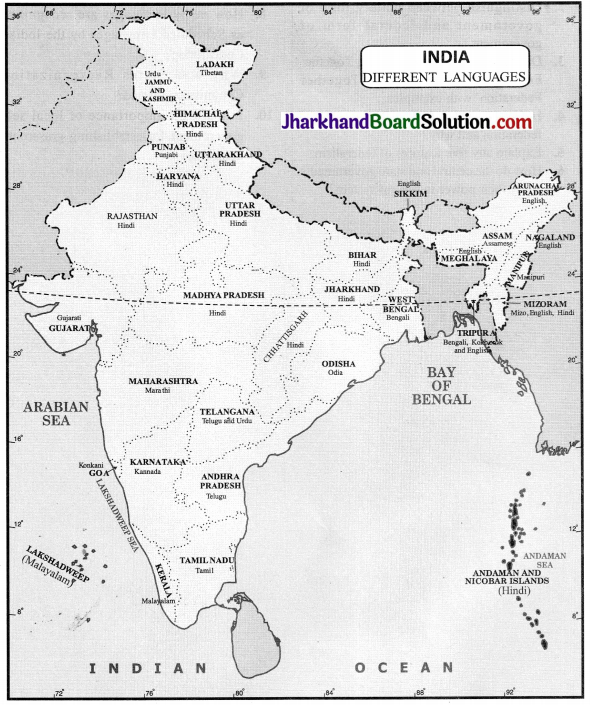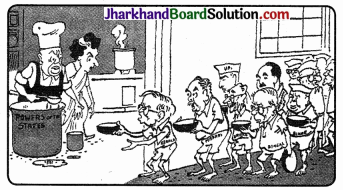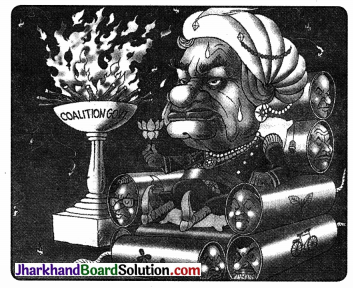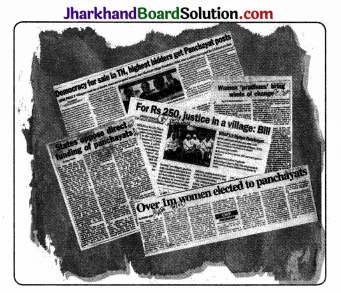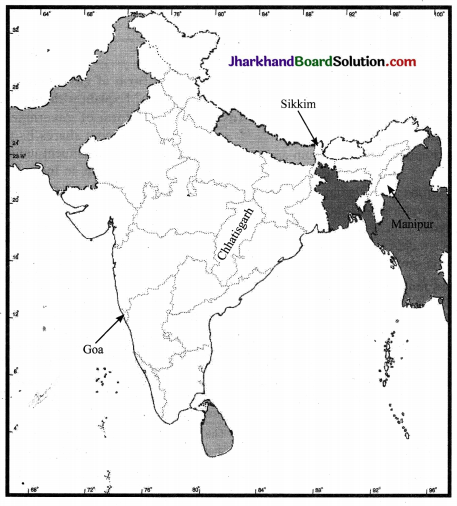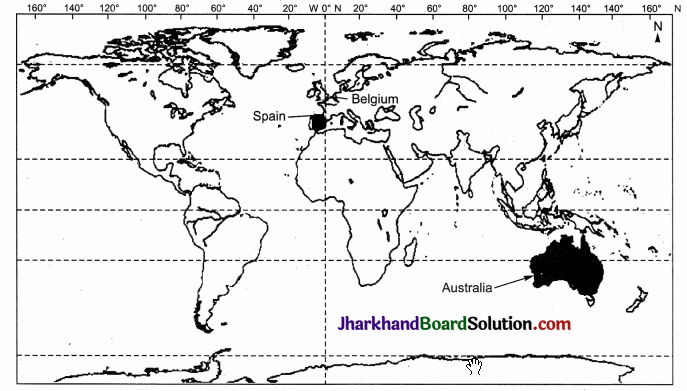JAC Board Class 10th Social Science Important Questions Civics Chapter 2 Federalism
Multiple Choice Questions
Question 1.
Which form of power sharing is most commonly referred to as federalism?
(a) Horizontal division of power
(b) Vertical division of power
(c) Division of power among various comnjunities
(d) Sharing of power among political parties
Answer:
(b) Vertical division of power
Question 2.
Which period saw the rise of regional political’parties in many States of the country?
(a) Period after 1990
(b) Period after 2000
(c) Period after 1980
(d) Period after 1970
Answer:
(a) Period after 1990
![]()
Question 3.
Which are the basic objectives of a federal system?
(a) To safeguard and promote unity of the country
(b) To accommodate regional diversity
(c) To share powers among different communities
(d) Both (a) and (b)
Answer:
(d) Both (a) and (b)
Question 4.
What are the kinds of routes through which federations have been formed?
(a) One route involves independent States coming together on their own to form a bigger unit.
(b) The second route is where a large country decides to divide its powers between the States and the national government.
(c) Both (a) and (b)
(d) None of these
Answer:
(c) Both (a) and (b)
Question 5.
In which Schedule of the Indian Constitution are the 22 scheduled languages included?
(a) Tenth schedule
(b) Eighth schedule
(c) Twelfth schedule
(d) Ninth schedule
Answer:
(b) Eighth schedule
Question 6.
Which of the following is incorrect regarding a unitary government?
(a) There is either only one level of government or the sub-units are subordinate to the Central government.
(b) The Central government can pass on orders to the provincial government.
(c) A State government is conservable to Central government.
(d) The powers of State governments are guaranteed by the Constitution.
Answer:
(d) The powers of State governments are guaranteed by the Constitution.
Question 7.
Which body conducts the elections to panchayats and municipalities?
(a) Election Commission
(b) State Election Commission
(c) State High Court
(d) Parliament
Answer:
(b) State Election Commission
![]()
Question 8.
What is true regarding sources of revenue in a federal system?
(a) States have no financial powers or independent sources of revenue.
(b) States are dependent on revenue or funds on the Central government.
(c) Sources of revenue for each level of government are clearly specified to ensure its financial autonomy.
(d) States have no financial autonomy.
Answer:
(c) Sources of revenue for each level of government are clearly specified to ensure its financial autonomy.
Question 9.
When was the use of English for official purposes stopped?
(a) 1956
(b) 1958
(c) 1960
(d) 1965
Answer:
(d) 1965
Question 10.
What is the third tier of government known as?
(a) Village Panchayats
(b) State Government
(c) Local Self-government
(d) Zila Parishad
Answer:
(c) Local Self – government
Very Short Answer Type Questions
Question 1.
Define federalism.
Answer:
Federalism is a system of government in which the power is divided between a central authority and various constituent units of the country.
Question 2.
How is a federal government organized?
Answer:
Power is divided between a central authority and various constituent units of the country.
Question 3.
What are the other factors besides politics that keep the federations united?
Answer:
Respect for diversity and desire for living together.
Question 4.
In which list of the Indian Constitution does a railway come? Why?
Answer:
It comes under Union List because it is a subject of national importance and requires a uniform policy throughout the country.
![]()
Question 5.
How much majority in the parliament is required to amend any part of the Indian Constitution?
Answer:
Any change to it has to be first passed by both the Houses of Parliament with at least a two-third majority.
Question 6.
What is meant by residuary subjects?
Answer:
The subjects which are not mentioned in Union, State and Concurrent Lists are called residuary subjects. The Union Government has the power to legislate on them.
Question 7.
Which level of government in India can make laws on the subjects included in the Concurrent List?
Answer:
Concurrent List includes subjects of common interest to both Union Government as well as the State Governments.
Question 8.
In a federalism, who resolves the disputes between different levels of the government?
Answer:
The highest court (e.g., Supreme Court in the case of India) acts as an umpire in case disputes arise between different levels of government.
Question 9.
Give an important feature of ‘holding together’ federation. Which are the countries where it exists?
Answer:
In this federation, the Central government tends to be more powerful vis-a-vis the States. ‘Holding together’ federations exist in India, Spain and Belgium.
![]()
Question 10.
What is a coalition government?
Answer:
Coalition government refers to a government formed by the coming together of at least two political parties. Usually, partners in a coalition form a political alliance and adopt a common programme.
Short Answer Type Questions
Question 1.
What makes India a Federal Country?
Answer:
- India is a nation with many languages, religions and regions. It emerged as an independent nation after a long and painful partition.
- Several princely states became a part of the country soon after independence. India was declared as a Union of States by the Constitution.
- The Indian Union is based on the principle of federalism.
- The Constitution earlier provided a two – tieir system of government the Union government (Central government) representing the Union of India and the State governments. Later Panchayats and Municipalities were added as a third tier of federalism.
- All these different forms of government enjoy separate jurisdiction.
Question 2.
When did Belgium shift from a unitary to a federal form of government? Why?
Answer:
- In 1993, Belgium shifted from a unitary to a federal form of government.
- It happened because the regional government were given constitutional powers and they were no longer dependent on the central government.
Question 3.
What do you mean by a unitary political system? Does Sri Lanka have a federal political system? What is the major demand of Tamil leaders in Sri Lanka?
Answer:
- In a unitary political system, the national government has all the powers in its hands.
- No Sri Lanka has a unitary political system.
- Tamil leaders want Sri Lanka to become a truly federal system.
Question 4.
How has the special status of Jammu and Kashmir changed?
Answer:
- The Jammu and Kashmir Reorganisation Bill, 2019 was passed by the Indian parliament in August 2019.
- The Bill proposed bifurcation of the state into two Union Territories – Jammu and Kashmir and Ladakh.
- The centre also revoked the special status of Jammu and Kashmir by withdrawing Article 370 of the Indian constitution.
- Jammu and Kashmir will have its legislative assembly, and Ladakh will be directly governed by the centre.
Question 5.
Write a brief note on the language policy adopted in India.
Answer:
- The ‘Language policy’ was the second test for Indian federation. No language was given the status of National language by our Constitution.
- Hindi was identified as the official language. But only about 40 per cent of Indians have Hindi as their mother tongue.
- 21 other languages besides Hindi, are recognised as Scheduled Languages by the Constitution.
- A candidate in an examination conducted for the Central Government positions may opt to take the examination in any of these languages.
- States too have their own official languages. Much of the government work takes place in the official language of the concerned State.
- The flexibility shown by Indian political leaders helped our country avoid any conflict based on languages.
Question 6.
Write a brief note on village councils.
Answer:
- Village councils looked after the affairs of the village, police and judicial powers and were the lines of contact with higher authorities on matters affecting the villages.
- Custom and religion elevated them to a sacred position of authority.
- These councils were the pivot of administration, the centre of social life, and, a focus of social solidarity.
Question 7.
What is a Gram Sabha? Describe any four functions of a Gram Sabha.
Answer:
Gram Sabha:
A body comprising all adult members of a village or a group of villages. Functions of Gram Sabha are as under:
- It elects the members of the Gram Panchayat.
- The Gram Sabha supervises the work of the village Panchayat.
- It apprqves the annual budget of the Panchayat.
- It reviews the performance of the Gram Panchayat.
Question 8.
Why is decentralization favoured in democracy? Identify any two reasons.
Answer:
(i) When power is taken away from Central and State governments and given to local government, it is called decentralization.
(ii) (1) The basic idea behind decentralization is that there are a large number of problems and issues which are best settled at the local level. People have better knowledge of problems in their localities.
(2) They also have better ideas on where to spend money and how to manage things more efficiently.
(3) Besides, at the local level it is possible for the people to directly participate in decision making. This helps to inculcate a habit of democratic participation.
Question 9.
Compare the federations of coming together type and holding together type.
| Coming Together Federation | Holding Together Federation |
| (i) Independent States come together on their own to form a bigger unit. | (i) A large country decides to divide its power between the constituent units and the national government. |
| (ii) All constituent States usually have equal power and the States enjoy certain amount of autonomy. | (ii) Central government tends to be more powerful. |
| (iii) The main aim of this federation is to pool their sovereignty and maintain their separate identity to increase their security. | (iii) In this type of federation, there is an absence of pooling sovereignty and maintaining identity. |
| (iv) Some examples are U.S.A., Australia and Switzerland. | (iv) Some examples are India, Belgium and Spain. |
Question 10.
Indian Constitution has a unitary bias. Support the statement with one example.
Answer:
The power sharing arrangement between the Union and the State given in the Constitution of India clearly distributes power between the two In this sense it is federal. But the system becomes unitary when the residuary power rests with the union.
Long Answer Type Questions
Question 1.
What are the duties of Central and State governments?
Answer:
- The duties of the Union or Central government include subjects of national
foreign affairs banking communications and currency. - This is because a uniform policy on these . matters will be maintained throughout
the country. All the laws pertaining to the above duties must be given only by the Union government. - The duties of the State governments include subjects of the State and local importance such as police, trade, commerce, agriculture and irrigation. All the laws pertaining to the above duties must be given only by the State governments.
- Some aspects have to be taken care of, by both, the Union government as well as the State goyemments. These are education, forest, trade unions, marriage, adoption and succession. Both governments can make laws on these subjects.
- If their laws conflict with each other, the law made by the Union Government will prevail.
Question 2.
Explain the power sharing, among government at different levels.
Answer:
The powers of government have been divided into three lists:
1. Union List:
It contains 97 subjects like defense, foreign affairs, railways, post and telegraphs, foreign trade and currency and coinage, etc. The Union government alone can make laws on subjects mentioned in this list.
2. State List:
It includes 66 subjects like police and jails, agriculture, public health, local government, trade and commerce, liquor, etc. The State governments alone can make laws on subjects mentioned in this list.
3. Concurrent List:
It includes 47 subjects like education, forests and trade union, marriage and divorce, etc. Both Union government as well as State governments can make laws on subjects mentioned in this list. In case of conflict, the law made by the Union government will prevail.
4. Residuary subjects:
Powers lie with the Centre. In such cases, only Parliament has the power to make laws on these subjects like computer software.
Question 3.
Critically analyze the Centre – State relations prior to 1990 and after.
- Prior to 1990, except for once, the Congress ruled at the Centre for about 40 years. These were the years when the single party made the government.
- The government at the Centre ruled the States with biased views. It supported those States which had a government formed by the same party.
- The rise of regional politics in many States has changed the Centre-State relations significantly after 1990. This was also the beginning of the era of coalition governments at the Centre.
- Since, no single party got a clear majority in the Lok Sabha, major national parties had to enter into an alliance with many small regional parties. Hence, regional parties do take care of their States.
- This led to a new culture of power sharing and respect for the autonomy of State government. It became difficult for the Central government to dismiss State governments in an arbitrary manner.
Question 4.
‘India has a large cultural, regional and religious diversity, but there is unity among people.’ What factors are responsible for this? Elaborate.
Answer:
The real success of federalism in India can be attributed to the nature of democratic politics in our country. This ensured that the spirit of federalism, respect for diversity and desire for living together became shared ideals in our country.
(i) The spirit of federalism:
The Constitution clearly provided a three-fold distribution of legislative powers between the Union government and the State governments.
(ii) Respect for diversity:
The creation of Linguistic States was the first and a major test for democratic politics in our country. This was done to ensure that people who spoke the same language lived in the same State. Some States were created not on the basis of language but to recognize
differences based on culture, ethnicity or geography.
(iii) Desire for living together:
Country decides to divide its power between the constituent States and the national government. The Constitution declared India as a Union of States, although, it did not use the word federation. In India, we have ‘holding together’ federation. In this second category, the Central Government tends to be more powerful vis-a-vis the State to keep the country united which has large cultural, regional and religious diversities.
(iv) Absence of national language:
Our Constitution did not give the status of national language to any one language. Hindi was identified as the official language. Besides Hindi, there are 21 other languages recognized as Scheduled Languages by the Constitution as safeguard to protect other languages. Much of the government work takes place in the official language of the concerned State.
(v) Independent Judiciary:
The judiciary plays an important role in overseeing the implementation of constitutional provisions and procedures.
![]()
Question 5.
In Panchayati Raj system l/3rd of the seats have been reserved for women. Do you feel that the same should be done for State Legislatures and Parliament? Support your answer with arguments.
Answer:
1. In favour:
(i) Many feminists and women’s movement feel that unless women control power their problems will not get adequate attention. This can be ensured with more women as elected representatives.
(ii) This problem can be solved legally binding to have a fair proportion of women in the elected bodies. This is what the Panchayati Raj has done in India. One – third of seats in local government bodies in panchayats and municipalities are now reserved for women.
(iii) Women’s organizations and activists have been demanding a similar reservation of at least one-third of seats in the Lok Sabha and State Assemblies for women. A reservation bill with this proposal has been pending before the Parliament for more than a decade.
(iv) Aims at eliminating gender inequality and discrimination against women through political empowerment of women.
2. In against:
(i) Question uota is not an answer to women’s problems and quota results in discrimination on the basis of gender violation of the democratic right of people to choose their representatives.
(ii) The reservation will only help elite women who are proxy of powerful men; women candidates may not get party ticket to contest from unreserved constituencies etc. Therefore, there is no need for reservations for women in the Legislatures.
(iii) Political parties should be made responsible to ensure distribution of tickets to various social and economic strata of society especially marginalized and disadvantaged groups, get adequate representation.
Question 6.
Explain the working of Local Self Government in India in rural areas?
OR
Briefly explain the levels of rural local government in India.
OR
How has Panchayat Raj system been organized?
Answer:
Rural local government is known as Panchayati Raj
(i) Village Level:
- Each village or a group of villagers in some states has a gram panchayat. This is a council consisting of several ward members, called panch and a president or sarpanch.
They are directly elected by all the adult population living in that ward or village - The Panchayat works under the overall supervision of the gram sabha. All the voters in the village are its members:
- It is the decision – making body for the entire village.
- It has to meet at least twice or thrice in a year to approve the annual budget of the gram panchayat.
- to review the performance of the gram panchayat.
(ii) Block Level
- A few gram panchayats are grouped togejher into panchayat samiti or block or mandal.
- All the panchayat members in that area elect the members of this representative body.
(iii) District Level
- All the panchayat samitis or mandals in a district together constitute the Zilla (district) parishad.
- Most members of the Zilla parishad are elected.
- Members of the Lok Sabha, MLA’s of that district and other officials of other district level bodies are also its members.
- Zilla parishad chairperson is the political head of the Zilla parishad.
Question 7.
What is gram sabha?
Answer:
- It is the village parliament (legislature). The panchayat under the supervision of the gram sabha.
- All the voters in the village are its members.
- It has to meet at least twice or thrice a year to approve the annual budget of the gram panchayat and to review the performance of the gram panchayat.
Question 8.
Explain the working of Local Self Government in India in rural areas?
OR
How are local bodies organized in urban areas?
Answer:
Local government bodies for urban areas:
- Municipalities are set up towns
- Big cities are constituted into Municipal Corporation.
- Elected bodies consisting of people’s representatives control both municipalities and municipal corporations.
- Municipal chairperson is the political head of the Municipality.
- In a municipal corporation such an officer is called the mayor.
Activity Based Questions
Question 1.
Prepare a linguistic map of India.
